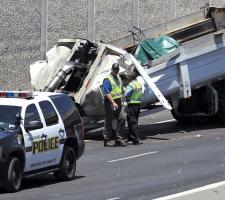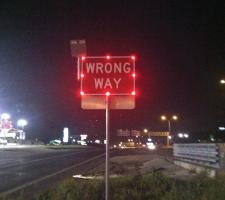
Dr John Miles
A study has shown the extent and ramifications of wrong way driving and proposed cost-effective countermeasures.
Wrong way driving collisions occur relatively infrequently but the results can be devastating. Statistics from the US5628 National Transportation Safety Board, an independent, federal all-modes agency, reveal that wrong way (WW) driving, account for only about 3% of accidents on high-speed divided highways but are much more likely to result in fatal and serious injuries.
Studies in US states have found WW driving death rates running at between 12 and 27 times higher than those for other types of accident. The majority (78%) of WW driving events events occur at night and a high proportion of WW drivers are suspected of being, or found to be, alcohol impaired.
Rising concerns among police and traffic management departments have brought pressure for tighter evaluation of crash data as the basis for developing effective countermeasures. A starting point was to bring together separate agencies to plan and develop joint responses and San Antonio’s WW Driver Task Force was set up in 2012.
The move followed local operators of TransGuide -375 Texas Department of Transportation’s (TxDOT) ITS-based traffic management system designed by San Antonio District - recording 185 incidents of WW drivers in the state’s second largest city. Of these, some 80% led to no accidents with the driver not being apprehended. But while 13 collisions resulted in no tragedies, another four caused seven deaths.
Other partners include TxDOT, the US831 Federal Highway Administration (FHWA) and the Texas Transportation Institute (TTI).
In January of 2011 San Antonio Police Department (SA Police) started recording all WW driver reports. In the spring of that year – following the WW driving-related death of a patrolwoman while on duty – the SA Police helped create the WW Driver Task Force.
TxDOT San Antonio TransGuide engineer John Gianotti told ITS International: “We’d been aware of the problem for some years. But the death of a policewoman spurred us into action.”
One of the task force’s First actions was to identify, for prioritisation, the city’s high-risk locations. It commissioned the Texas Transportation Institute (TTI) to develop a geographic information system (GIS) map showing the sites of reports of WW drivers.
TTI drew on TransGuide’s operator logs and crash record information system findings (filtered for events that included the term ‘wrong way’), and the SA Police’s 911 (emergency) call logs. Radar detection was used for real-time geolocation of events.
Although operator logs and 911 calls identify the location of the accident or the position of the 911 caller, WW drivers are rarely seen in the act – such as using an exit ramp to try and enter a freeway in the wrong direction. Out of the 358 WW driving events reported via 911 calls to the SA Police, only five identified the entry point.
Where there is accurate location information it is possible to target alerts to the driving public via TransGuide’s dynamic message signs (DMS), and to SA Police dispatchers who can warn nearby patrol cars via the ‘E-Tone’ radio network. Back in May 2011, TxDOT authorised TransGuide operators to display WW driving warnings immediately the SA Police issues an E-Tone alarm; previously they had to verify the incident before setting messages.
Because CROSS streets and interchanges figure heavily in reported locations, the conventional GIS approach of showing a dot for each event resulted in superimpositions that failed to clarify the level of risk. Therefore TTI introduced spatial analysis technology that delivered a density map highlighting WW driver hotspots.
TxDOT says it had considered the feasibility of using the location of drinking places to identify the nearest exit ramps as high-risk sites. But SA Police investigation showed that drunken drivers were often some way along the freeway before leaving at the wrong point and then trying to re-enter in the wrong direction.
The pilot involved equipping both exit ramps and highway sections with radar detection units to detect wrong way drivers and LED illuminated ‘wrong way’ signs to warn drivers of a vehicle travelling in the wrong direction. In addition, LED blank out signs were positioned on both shoulders. These remain blank most of the time but when activated will display a ‘Wrong Way’ message to errant drivers. Equipment suppliers are989 TAPCO (LED signs), 7846 SES America (blank out signs) and 148 Wavetronix (radar detectors).
Analysis after a 14-month period (July 2012– August 2013) has shown a reduction of almost 30% in WW driving events (see table). Gianotti told ITS International that he was “very pleasantly surprised” at the scale of the improvement. “I expected less,” he said.
Concurrently, TxDOT began a two-year research project, starting in autumn 2012, which is evaluating the effectiveness of countermeasures implemented in San Antonio as well as elsewhere in Texas and at other locations around the US. It is also reviewing the current guidelines for deploying illuminated sign applications listed in the FHWA’s Manual on Uniform Traffic Control Devices and making best practice recommendations.
New ITS Handbook previewing in Helsinki
The 2014 ITS European Congress (Helsinki, Finland 16-19 June) will highlight a development of the informational support for ITS including input from the World Road Association (2237 PIARC). Currently under way is the updating of the established PIARC ITS Handbook and its transformation into a web-based knowledge resource for the benefit of transportation professionals and students worldwide.
Funded by the ITS Joint Program Office in the US Department of Transportation (USDOT) on behalf of PIARC, the project will create an authoritative source of information on a full range of ITS topics. It is being written with practitioners’ needs in mind and will have an international perspective to take into account issues relevant to countries with economies in transition.
The PIARC Handbook will cover ITS benefits, enabling technologies, human factors, traveller support, passenger transport, freight and commercial operations, safety, network monitoring and evaluation, strategic planning, ITS architecture, systems engineering and deployment. IBEC has provided members to serve on the editorial team and to write and review the content.
IBEC sees this as part of its role in supporting colleague organisations in their efforts to further understanding of the role of technology in transforming transportation – not least through its ability to offer cost-effective solutions to the challenges it faces.
USDOT has contracted ITS America to oversee the project.560 ITS America has subcontracted IBEC members John Miles and Finella McKenzie – both members of Transport Associates Network - as editor and associate editor respectively, to direct the work of 19 specialist authors in developing the content.
In a parallel project, PIARC is overseeing the transfer to the web of its Road Network Operations Handbook, prepared by its technical committee on network operations. PIARC is planning to bring the two projects together to create an integrated online knowledge resource with comprehensive coverage of ITS in practice and how it relates to road network management.
The combined Road Network Operations-ITS web resource will be organised as a series of modules - structured specifically for website viewing, rather than in traditional book format with chapters. Modules contain case studies, multimedia content such as videos as well as links to related content in other modules.
IBEC chair Thomas Kern is encouraging Helsinki delegates to attend the session showcasing this knowledge resource which will be launched later in 2014.
PIARC is an international non-profit group based in Paris, France and brings together the road administrations from 120 governments and has members in more than 140 countries.
Wrong way driving collisions occur relatively infrequently but the results can be devastating. Statistics from the US
Studies in US states have found WW driving death rates running at between 12 and 27 times higher than those for other types of accident. The majority (78%) of WW driving events events occur at night and a high proportion of WW drivers are suspected of being, or found to be, alcohol impaired.
Rising concerns among police and traffic management departments have brought pressure for tighter evaluation of crash data as the basis for developing effective countermeasures. A starting point was to bring together separate agencies to plan and develop joint responses and San Antonio’s WW Driver Task Force was set up in 2012.
The move followed local operators of TransGuide -
Other partners include TxDOT, the US
In January of 2011 San Antonio Police Department (SA Police) started recording all WW driver reports. In the spring of that year – following the WW driving-related death of a patrolwoman while on duty – the SA Police helped create the WW Driver Task Force.
TxDOT San Antonio TransGuide engineer John Gianotti told ITS International: “We’d been aware of the problem for some years. But the death of a policewoman spurred us into action.”
One of the task force’s First actions was to identify, for prioritisation, the city’s high-risk locations. It commissioned the Texas Transportation Institute (TTI) to develop a geographic information system (GIS) map showing the sites of reports of WW drivers.
TTI drew on TransGuide’s operator logs and crash record information system findings (filtered for events that included the term ‘wrong way’), and the SA Police’s 911 (emergency) call logs. Radar detection was used for real-time geolocation of events.
Although operator logs and 911 calls identify the location of the accident or the position of the 911 caller, WW drivers are rarely seen in the act – such as using an exit ramp to try and enter a freeway in the wrong direction. Out of the 358 WW driving events reported via 911 calls to the SA Police, only five identified the entry point.
Where there is accurate location information it is possible to target alerts to the driving public via TransGuide’s dynamic message signs (DMS), and to SA Police dispatchers who can warn nearby patrol cars via the ‘E-Tone’ radio network. Back in May 2011, TxDOT authorised TransGuide operators to display WW driving warnings immediately the SA Police issues an E-Tone alarm; previously they had to verify the incident before setting messages.
Because CROSS streets and interchanges figure heavily in reported locations, the conventional GIS approach of showing a dot for each event resulted in superimpositions that failed to clarify the level of risk. Therefore TTI introduced spatial analysis technology that delivered a density map highlighting WW driver hotspots.
| US 281 pilot project results - July 2012 to August 2014 | |
|---|---|
| Reduction in average rate of WW Driving events: TxDOT TransGuide logs | 29.11% |
| Reduction in average rate of WW driving events: SAPD logs | 29.77% |
| Project cost | US$377,605 |
| Annual Cost savings: average of TxDOT and SAPD data | US$246,508 |
| Benefit-cost ratio | 13.1* |
| Cost recovery time (years) | 1.5 |
TxDOT says it had considered the feasibility of using the location of drinking places to identify the nearest exit ramps as high-risk sites. But SA Police investigation showed that drunken drivers were often some way along the freeway before leaving at the wrong point and then trying to re-enter in the wrong direction.
Pilot
Analysis of the GIS mapping showed the highest level of WW driving as being on a 24km stretch of the US 281 corridor running northwards from downtown San Antonio. The task force therefore chose this as a suitable section for funding a pilot project to test countermeasures.The pilot involved equipping both exit ramps and highway sections with radar detection units to detect wrong way drivers and LED illuminated ‘wrong way’ signs to warn drivers of a vehicle travelling in the wrong direction. In addition, LED blank out signs were positioned on both shoulders. These remain blank most of the time but when activated will display a ‘Wrong Way’ message to errant drivers. Equipment suppliers are
Analysis after a 14-month period (July 2012– August 2013) has shown a reduction of almost 30% in WW driving events (see table). Gianotti told ITS International that he was “very pleasantly surprised” at the scale of the improvement. “I expected less,” he said.
Concurrently, TxDOT began a two-year research project, starting in autumn 2012, which is evaluating the effectiveness of countermeasures implemented in San Antonio as well as elsewhere in Texas and at other locations around the US. It is also reviewing the current guidelines for deploying illuminated sign applications listed in the FHWA’s Manual on Uniform Traffic Control Devices and making best practice recommendations.
New ITS Handbook previewing in Helsinki
The 2014 ITS European Congress (Helsinki, Finland 16-19 June) will highlight a development of the informational support for ITS including input from the World Road Association (
Funded by the ITS Joint Program Office in the US Department of Transportation (USDOT) on behalf of PIARC, the project will create an authoritative source of information on a full range of ITS topics. It is being written with practitioners’ needs in mind and will have an international perspective to take into account issues relevant to countries with economies in transition.
The PIARC Handbook will cover ITS benefits, enabling technologies, human factors, traveller support, passenger transport, freight and commercial operations, safety, network monitoring and evaluation, strategic planning, ITS architecture, systems engineering and deployment. IBEC has provided members to serve on the editorial team and to write and review the content.
IBEC sees this as part of its role in supporting colleague organisations in their efforts to further understanding of the role of technology in transforming transportation – not least through its ability to offer cost-effective solutions to the challenges it faces.
USDOT has contracted ITS America to oversee the project.
In a parallel project, PIARC is overseeing the transfer to the web of its Road Network Operations Handbook, prepared by its technical committee on network operations. PIARC is planning to bring the two projects together to create an integrated online knowledge resource with comprehensive coverage of ITS in practice and how it relates to road network management.
The combined Road Network Operations-ITS web resource will be organised as a series of modules - structured specifically for website viewing, rather than in traditional book format with chapters. Modules contain case studies, multimedia content such as videos as well as links to related content in other modules.
IBEC chair Thomas Kern is encouraging Helsinki delegates to attend the session showcasing this knowledge resource which will be launched later in 2014.
PIARC is an international non-profit group based in Paris, France and brings together the road administrations from 120 governments and has members in more than 140 countries.







